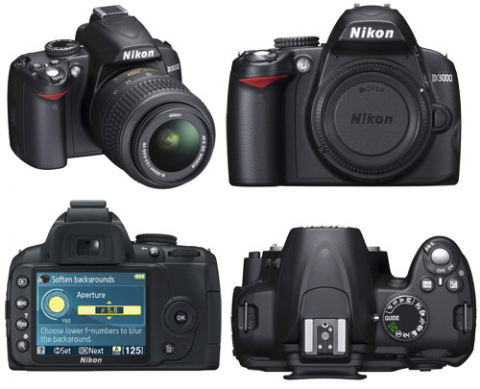Your Nikon Guide: What’s So Special About The Nikon D3000
After our short Coolpix guide, it seemed quite natural to discuss about the DSLR sector from Nikon. Obviously, we cannot cover all their DSLRs with one single article, therefore I will go for each model in its own separate page – and today we shall discuss about their entry-level DSLR, the D3000.
First of all, I need you to notice that technology is a lot easier to use nowadays – it may seem like an obvious statement but bare with me – most cameras back in the old days needed a real guide, if possible an entire book just for you to know how to use them right (and I mean DSLRs, not compact cameras). They simply were not built for people that had nothing to do with professional photography or did not have the time or the energy to be willing to learn something about it. Now, whenever I look at models such as the D3000 I cannot help but wonder how easy they are to use.
Nikon D3000
Okay, so this is your camera. First off, its lightweight – and I mean really lightweight for a DSLR. Second, it is user-friendly – notice in the lower left quadrant how colorful and beautiful the menu is? Well, that is how the whole camera is built – for you to have fun with it at all times. Not only that it helps you pick the right settings for a certain scene, it sets up a lovely wizard, which guides you throughout the settings, and explaining what each setting stands for each step of the way.
11-points focalization system
What does this mean? Every time you use the Auto-Focus function in Nikon D3000, your camera uses precisely 11 points to focus on the desired subject. Displayed in a diamond shape, the 11 points are more than enough to cover the desired subject, especially if you are not very pretentious about your photographs (or you are still learning).
Scene recognition in Nikon D3000
Think of a camera that thinks ahead of you – think of a sensor that manages to evaluate the composition of your image and adjust all the necessary settings accordingly. Settings such as White Balance or exposure can be tricky at times, however, the RGB sensor (using 420 pixels) manages to help you build a beautiful picture in no time at all.
Active D-Lighting
We have all taken pictures in broad daylight and had a lot of trouble trying to compensate for the amount of light in the picture. Well, consider this a giant step up from the usual techniques – in other words, what active D-Lighting does is to help you take pictures with high contrast between lighted areas and darker ones which will normally lead to a loss in tones and details. This is where D-Lighting steps in and beats this particular effect by holding on to the important details from the shadowed areas. The result? Excellent photographs with optimal exposure and all with no stress at all.
Picture Control in Nikon D3000
So you’ve taken your picture, and maybe you can post-process it – but are there any presets you can consider before taking your picture? Certainly! You can personalize your pictures way before you’ve taken them with Picture control. The six settings that come embedded into your camera can enhance your creative capabilities – go for Standard, Neutral, High-Contrast, Monochrome, Portrait or Landscape in order to modify the look of your images based on subject or image. Every setting can be adjusted in order to offer more control over sharpness, contrast or other similar effects.



